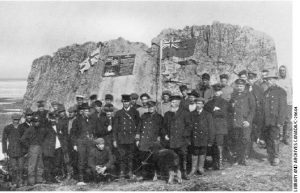
High in the Canadian Arctic, working from a camp on Borden Island, a group of scientists uses autonomous vehicles to survey the floor of the Arctic Ocean. If they are successful in proving that Canada’s continental shelf is connected to a region around the geographic North Pole, their work will support the Canadian government’s assertion of sovereignty over the Far North. Canada has announced plans to stake a claim under the United Nations Convention on the Law of the Sea to an area that could comprise 1.7 million km2, roughly the size of the Prairie Provinces. A successful claim would change our maps and, more significantly, our responsibilities as stewards of the North.
For roughly 300 years, coastal nations claimed sovereignty under customary law over a narrow region along their coastlines and the high seas were governed by the principles of the Freedom of the Seas. Such freedom encompassed fishing, trade, travel, navigation, warfare and research. In 1945, the United States claimed jurisdiction over the natural resources of its continental shelf beyond its territorial limits; other nations quickly followed suit. In 1967, to satisfy the need for changes to the law of the seas, the United Nations undertook a conference comprising a series of sessions spanning 15 years to produce a comprehensive set of laws known as the United Nations Convention on the Law of the Sea, or UNCLOS. The convention recognizes a nation’s sovereignty over natural resources within 200 nautical miles and allows territorial claims up to 350 nautical miles from shore provided the country can prove that its continental shelf extends beyond the 200-mile limit.
Canada asserts that the waters of the Arctic Archipelago, including the Northwest Passage, are internal, resting its claim to the North on history and proximity, but the promise of energy resources has prompted challenges from other nations. The United States, Russia, Norway and Denmark are all staking similar claims. It is already apparent that some claims — those of Canada, Russia and Denmark, for example — will overlap. Nothing in UNCLOS compels the arctic countries to accept the recommendations of a UN commission ruling on competing claims. No one could predict what would happen should the commission leave it up to individual countries to deal with disputed boundaries in energy-rich areas. The region could even be open to claims from countries with no physical connection; Chinese Rear Admiral Yin Zhuo stated recently in comments relayed by the official China News Service that the “Arctic belongs to all the people around the world as no nation has sovereignty over it.”
Canada’s original claim to the North lies in the 1670 charter granted by Charles II giving Rupert’s Land to the Hudson’s Bay Company. Today’s Northwest Territories and Nunavut were added in 1821. When HBC transferred its title to the Dominion of Canada in 1870, the new nation acquired sovereignty over the northern territories but not over the islands north of the mainland. In July 1880, the British government transferred to Canada the rest of its arctic possessions, including “all Islands adjacent to any such Territories” whether discovered or not. Britain’s right to give Canada undiscovered islands, those discovered by foreign interests or regions inhabited by the Inuit was dubious at best.

Since the 1880s, the Canadian government has sporadically undertaken ventures to secure arctic sovereignty. Government sponsored voyages were made by explorers such as Joseph-Elzéar Bernier and Vilhjalmur Stefansson who left plaques or cairns and raised flags on several islands, including Ellesmere and Melville. However, such symbolic acts are insufficient under international law. Besides, they weren’t alone in their explorations. Americans Adolphus Greely and Robert Peary were busy around Ellesmere Island at the same time, and between 1898 and 1902 Otto Sverdrup became the first person to set foot on the islands of Axel Heilberg, Ellef Ringnes and Amund Ringnes; even the Inuit had not been to the islands. Sverdrup claimed them for Norway.
The first real assertion of Canadian sovereignty was made in 1903 with a North West Mounted Police post on Herschel Island. The RCMP operated a post office on Bache Peninsula, although no one lived anywhere near it; despite once-a-year mail delivery, the operation of a post office was proof of sovereignty. In 1931, Norway formally abandoned its claim to the Sverdrup Islands and Canada paid $67,000 for the records of the Sverdrup expeditions.
The reason for the current activity in the High Arctic came to light in the 1950s due to exploration by the oil and gas industry and the Geological Survey of Canada. In 1967, a partnership between government and industry created a consortium, Panarctic Oils Ltd., which began drilling on Melville Island as a show of Canadian arctic sovereignty. In 1969, Panarctic discovered a gas field at Drake Point that held an estimated 99 billion cubic metres of gas. By the late 1980s, Panarctic had drilled more than 400 wells. Low gas prices, high transportation costs and the end of government incentives brought the consortium down. That may ultimately have been cause for celebration, because the company’s environmental record was poor. Besides dumping tonnes of junk steel and waste oil into the Arctic Ocean, the company had several well blowouts. The worst occurred in 1970 when the King Christian Island well blew, causing a fireball so hot it collapsed the ground around the camp. It spewed gas and fire for more than three months before it was brought under control.
Today, while scientists map the undersea geography, others from the Geological Survey of Canada and survey departments of other nations seek signs of gas and oil. Geological studies suggest that there are more than 400 oil and gas fields north of the Arctic Circle, estimated to contain 90 billion barrels of oil, 1.6 trillion cubic feet of natural gas, and 44 billion barrels of natural gas liquids, of which approximately 84 percent is expected to be found offshore, beneath waters that are ice-covered for most of the year. The extensive exploration makes arctic sovereignty about more than territoriality, defence or mineral rights. Sovereignty is the key to protecting a vulnerable and crucial environment.
Canada, historically, has not been very committed to asserting its authority “from sea to sea to sea.” However, the December 2009 Report of the Standing Committee on Fisheries and Oceans of the Canadian Senate recommended “that Canada develop a long-term plan and provide the funding necessary for the acquisition of a suitable number of new multi-purpose polar icebreakers capable of operating year-round in its Arctic Archipelago and on the continental shelf.” To that end, the government is pursuing a project worth $3.1 billion to build five new ice-class Coast Guard vessels, with delivery of the first anticipated in 2014. The new vessels would require an additional commitment of $4.3 billion for operation and maintenance for their expected life span of 25 years. This implied commitment to standing on guard for the “true north” is also a pledge to facilitate increased traffic in arctic waters — traffic not only for transporting goods to market but delivering oil out of the sea, traffic that could very well be more than the fragile environment could take.
And what of the Inuit? More than 50,000 Inuit live in Canada (2006 census). Industrial development in the North would bring extensive economic changes to them, but at the risk of their traditional way of life. More significantly, the North is among the areas that will feel the first and most substantial effects of climate change. As permafrost and sea ice melt and shorelines erode, the fabric of northern life will dissolve along with them. According to Steven Ferguson, leader of the department of fisheries and ocean’s global warming and arctic marine mammals (GWAMM) project, declining sea ice appears to be shifting the Hudson Bay marine ecosystem from “a polar bear-seal system with Inuit hunters at the apex to one dominated by cetaceans with killer whales at the apex.” Furthermore, the changes are happening more rapidly than expected; predictions of ice-free summers in the Arctic in 100 years have been re-evaluated to five years.
An event similar to the Gulf of Mexico disaster in this Arctic environment could be more catastrophic than we can imagine. It would probably exacerbate the effects of global climate change by creating instability of the sea ice and speeding pack ice melting. It would cause the growth of algae and plankton, seriously harming fish and marine birds. Larger animals such as polar bears would be harmed as well, according to environmental scientists like William Adams who was one of the researchers of the decade-long 1976 Beaufort Sea Project, which studied the impact of an oil spill in the Beaufort. Cleaning up an arctic spill would be much more difficult than a spill in any other environment — imagine rescuing oil-covered polar bears.
There is substantial evidence that the arctic environment is at risk, and with it the traditional existence of the Inuit people; global warming has opened the Northwest Passage and caused increased glacial melting. Exploiting the Arctic’s natural resources, particularly offshore, will increase that risk. The explosion of a British Petroleum well in the Gulf of Mexico has shown the world the impact of a failed offshore oil rig. The damaged well pouring tens of thousands of barrels of oil a day into the ocean for months has proven the insufficiency of safety regulations and the unpreparedness of corporate oil to cope with the failure of its equipment. When the BP rig exploded, the company was actually trying to convince Canada’s energy regulator that safety standards established for offshore drilling in the Arctic were “expensive, impractical and should be relaxed.” Offshore exploratory drilling was scheduled to begin in the Arctic in July of this year, but the well failure brought hearings to an end and Canada imposed a stay on drilling pending a review of existing rules.
Although Canada’s environmental record is far from spotless, we would be foolish to absolve ourselves of the responsibility to protect our vulnerable northern coastline.
Laura Neilson Bonikowsky is a writer from Alberta.





